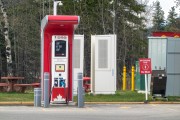Lately it's been pretty quiet here in "Transit Nation." This may be the calm before the storm; surely any day now we will learn the fate of Mayor Ford's newest transit proposal. Will the Mayor's office and Metrolinx agree on a new plan for $8.7 billion of provincial transit money? Will the new plan go to City Council for a vote?
In advance of any final decision, Pembina has completed an analysis of the new plan (which is currently in the hands of Metrolinx), comparing how it stacks up against phase one of Transit City.
But our new report doesn't just compare and contrast opposing plans — it also scours the Mayor's plan for potential 'goodies' and offers up some important recommendations to help make his proposed plan more cost effective, more successful and inclusive of broader interests.
Stop debating, start building
With Toronto in a decades-old transit deficit, we need to get shovels in the ground now, rather than stalling in ongoing debate. The Mayor's proposed transit plan prioritizes provincial funding to two rapid transit lines for which environmental assessments and other groundwork have been completed (under Transit City), which means we can get on with building.
The plan prioritizes Eglinton, which has the highest ridership and serves a community that has waited decades for rapid transit. It also proposes light rail to replace the aging Scarborough rapid transit line, which is the more cost-effective option than the Mayor's original preference for a subway on that route.
How it stacks up
The table below compares the costs and benefits of Mayor Ford's new transit proposal to the former four LRT priority projects (Phase One of Transit City). It also presents the Mayor's full transit plan, including a Sheppard subway, which the mayor intends to fund with private partnerships.
Compare the original four LRT lines (Phase One of Transit City) to Mayor Ford's new proposal. For the same budget of $8.7 billion, Ford's plan:
- serves less than half as many Torontonians;
- serves half as many low-income people;
- does not include Finch, currently the busiest bus route in Toronto;
- leaves out the north-west region of Toronto (Finch), which has the highest low-income population and currently the poorest access to rapid transit.
The plan actually leaves out a Sheppard line as well. The Mayor's insistence on a subway for Sheppard means that the original Sheppard LRT (part of Transit City) is no longer included in the provincial budget; therefore, a private financing strategy no longer guarantees the residents of Sheppard a rapid transit line.
Mayor Ford's larger plan includes a privately-financed Sheppard subway, but whole plan would cost about $4 billion more than the original LRT plan and serve 25 per cent fewer Torontonians (see maps).
Mayor Ford’s Larger Plan: 37 km for $12.5 billion
Committed provincial funds for LRT (in blue): 25 km for $8.7 billion
Unsecured funds for Sheppard Subway (in red): 12 km for $4.4 billion*
* The province plans to contribute $650 million to the Sheppard subway from the $8.7 billion budget so total is $12.5 billion instead of $13.1 billion
The Original LRT Plan: 52 km for $8.7 billion
Four LRT priority projects — Phase One (Funded phase of Transit City)
Saving dollars and sense
The proposal to bury the entire Eglinton LRT underground adds $2 billion to the provincial budget and squeezes out funding for Finch. While going underground certainly has its benefits, it makes underground LRT as expensive per kilometre as the Sheppard subway.
Finch is the busiest bus route and ridership is increasing. An "express bus" will not provide adequate capacity. A Finch LRT is the most affordable of all transit lines being proposed by the former LRT plan or the new plan. Compare the following:
- 11 kilometres Finch LRT: $0.9 billion
- 12 kilometres Sheppard Subway: $4.4 billion
- 8 kilometres of newly-proposed Eglinton underground: $2 billion
Rethinking surface transit in the plan
With Finch such a comparative 'bargain,' the exclusion of Finch is likely a decision to exclude any surface rapid transit that is not fully segregated (like the SRT) from the scope of the plan.
But surface LRT has many benefits. Not only is it one-third the cost of underground rapid transit to build, it also costs less to maintain, light, keep safe and secure, and clean. Surface LRT can be built faster. Some lines could open in as little as two years. The existing Sheppard subway took a decade.
It is a myth that light rail transit is going to affect congestion, when in fact congestion is reduced by getting more people on transit. Spreading the budget over a broader area results in greater ridership and less congestion: the four LRT priority lines would remove up to twice as many vehicles from traffic congestion as the current transit proposal.
It is also a false assumption that right-of-way surface LRT takes lanes away from cars. Except for 300 metres at the CPR bridge, the Finch LRT would not require any lanes removed from traffic.
Scoping Sheppard
The provincial budget includes a $650,000 contribution towards a Sheppard subway; however, these dollars are apparently supposed to go towards the subway only if money is left over after spending on other lines.
If a financing plan does not succeed, that $0.65 billion is potentially lost where it could otherwise have gone towards funding a guaranteed Sheppard LRT. In addition, the city is financially responsible for paying back investors if the level of intensified development required to generate revenue does not materialize.
If a private financing plan that depends on development charges does comes through, the residents of Scarborough need to be aware that getting a Sheppard subway may mean their neighbourhood will have to look like Yonge and Sheppard in order to pay for it.
Regardless, the City should examine all cost-effective capital and operating options for a Sheppard rapid transit line in conjunction with private investors. Effective complementary urban development and planning policies should be studied by the city to ensure that the development densification along Sheppard generates the level of revenue necessary to pay private investors, but also happens in consultation with the community that will incur it.
Making it work
In summary, we suggest a few key modifications or stipulations to the plan currently on the table:
- Commence work on the 11 kilometres of original underground for Eglinton Crosstown and the Scarborough SRT, but revisit and re-examine the plan and budget to bury the other eight kilometres of Eglinton in four to five years.
- Re-engineer the budget to include a Finch LRT. Reconsidering portions of underground for Eglinton and/or a provincial contribution to Sheppard subway could free up funds for Finch.
- Hold back the $650 million provincial contribution to a Sheppard subway in reserve until a comprehensive examination of options for Sheppard is conducted in consultation with the community.·
These tweaks could make this plan more successful, address broader interests, stretch the budget further, reduce financial risks to the city — and get shovels in the ground now.









